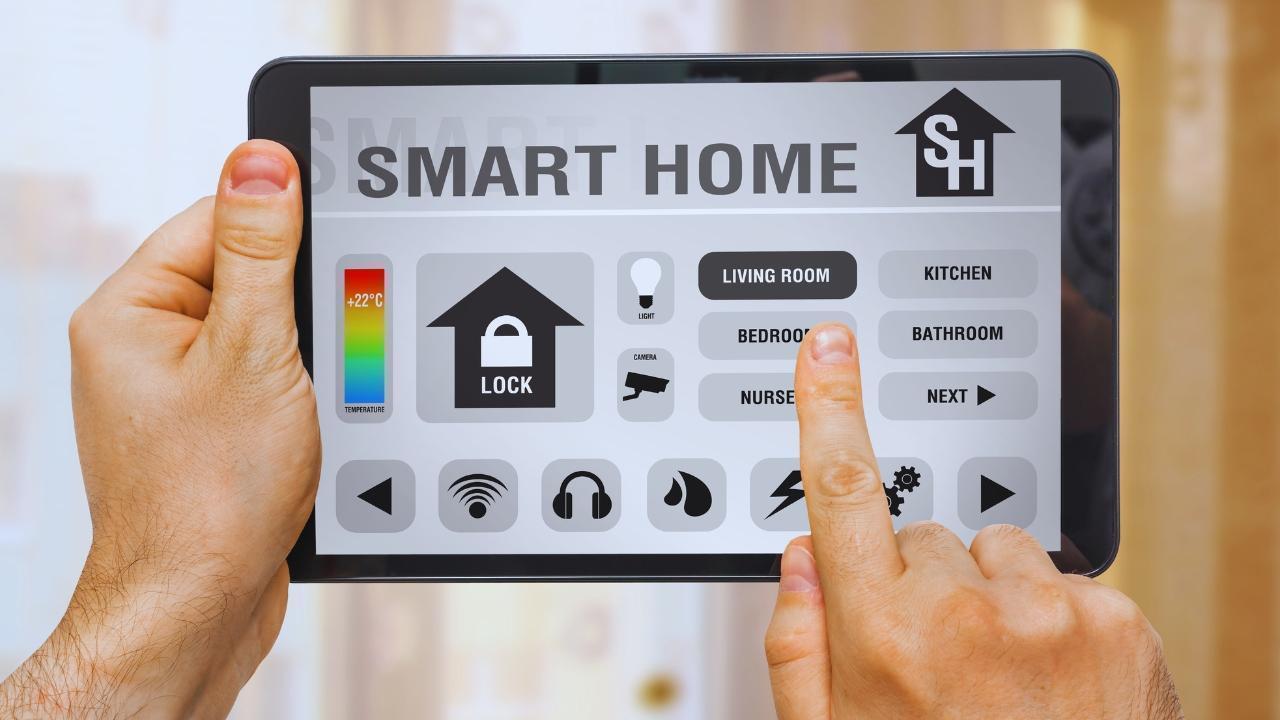
Join 10k+ people to get notified about new posts, news and tips.
Do not worry we don't spam!

Post by : Anis Farhan
Smart homes used to look like a mess of apps, hubs, and blinking lights. Today, the best ones don’t shout—they blend in. Cables disappear, controls feel natural, and the entire system quietly works in the background. Around the world, the biggest trend in home technology isn’t just adding more gadgets; it’s integrating them so they feel like part of the home’s architecture. Functionality now walks hand in hand with design, and that shift is changing how we build, furnish, and live in our spaces.
For years, “smart” meant visible tech—big touchscreens, wall switches, and a dozen brand logos. Now, the design goal is to make technology nearly invisible. Flush-mounted sensors tuck into ceilings. Soundbars disappear into joinery. Lighting scenes replace rows of switches with one clean control. Even the interfaces are slimming down—voice, presence detection, and gentle, glanceable notifications replace complicated menus. The home looks calmer because the tech has been woven into the structure rather than layered on top.
The smartest decision in a smart home is to prioritize devices that talk to each other. Homeowners are choosing platforms and ecosystems that let lights, locks, shades, HVAC, security, and appliances act as one system. That single decision does more for day-to-day comfort than any individual gadget. The outcome is reliability: your motion sensor triggers lighting, your thermostat whispers to your shades, and your door lock cues the entry lights and soft music—without you juggling apps. Integration has become the headline feature, not a footnote.
Wellness is no longer a luxury add-on; it’s a core brief. Tunable white lighting follows the body’s natural rhythms—cooler light for focus during the day, warmer light as evening arrives. Air-quality monitors now steer ventilation and filtration automatically, telling your system to flush out stale air, reduce humidity, and trap particulates. Quiet matters, too: acoustic panels, soft-close mechanisms, and noise-aware sound systems reduce stress. The most-loved wellness feature? Smart blackout shades paired with dawn-simulating lights that make mornings softer and sleep deeper.
The most valuable smart feature right now is energy awareness. Smart thermostats aren’t new, but how they partner with the rest of the home is. Window and door sensors pause cooling when a patio door opens. Ceiling fans work with HVAC to reduce compressor load. Water heaters pre-heat when electricity is cheapest. Solar plus batteries go from “nice to have” to “household CFO,” storing cheap or self-generated power for evening use. The idea is simple: use less, waste less, and make what you do use count.
Appliance design has matured. Induction cooktops vanish beneath a counter finish. Ovens preheat when a recipe starts, not when you remember. Fridges track temperatures by zone without turning into nagging billboards. Coffee makers and dishwashers nest behind cabinetry for a clean visual line. The best part isn’t the novelty—it’s the flow. The kitchen becomes a well-tuned workstation that anticipates rather than interrupts, all while looking like a magazine spread instead of a control room.
Good security should feel like comfort, not paranoia. Discreet cameras sit behind tinted glass. Doorbell units match the trim. Smart locks choose natural finishes. Inside, you get practical scenes: a “Goodnight” button that checks doors, arms the alarm, and tucks the lights into a low glow. Presence simulation makes the home seem lived-in when you’re away by randomizing lights and music, not looping the same pattern every night. You feel protected, and your home still looks like, well, a home.
Privacy concerns are shaping purchasing choices. Many homeowners now prefer devices that process data locally—on a hub or even directly on the device—before sending anything to the cloud. Cameras that can store footage on a local drive, voice assistants that perform basic commands offline, and apps that don’t harvest data have become strong selling points. This “privacy by default” approach pairs well with good design because it reduces the number of boxes and cables needed for connectivity.
Screens haven’t disappeared; they’ve matured. Instead of sticking a tablet onto every wall, homes are using ambient displays—subtle floor-level LEDs for night paths, light strips that signal air-quality changes, or tiny e-inks with room temperature and calendar highlights. Voice is still handy, but ambient cues are less intrusive and more elegant. A soft glow under the kitchen counter that says “dishwasher done” is nicer than a beeping machine or a flashing phone.
The most important design decision often hides in the wiring plan. Pre-wiring for data, power, and low-voltage lines ensures the home stays flexible for the next decade. A strong mesh Wi-Fi backbone covers big spaces and tricky corners. Low-power mesh protocols keep battery sensors alive for years, not months. The outcome: fewer dead spots, fewer service calls, and a foundation that lets your system grow without tearing up walls.
Smart integration looks different in a compact city apartment than in a sprawling villa. In small spaces, multi-use devices win: a single smart speaker that’s also a hub and intercom; a compact, all-in-one climate controller; a convertible standing desk with built-in cable management and power. In large homes, zoning takes the spotlight: separate scenes for each wing, distributed audio with per-room control, and tiered lighting layers that can be set for entertaining or quiet evenings. The point is not to buy more; it’s to buy what fits.
You don’t need a new build to live smart. Retrofit-friendly devices—battery-powered shades, stick-on occupancy sensors, screw-in dimmers, and adhesive LED strips—make upgrades painless. Modular light switches that snap into existing boxes let you modernize without replastering. Even radiators and window AC units can get “smart” with plug-in controllers and temperature probes, turning old systems into responsive, app-aware comfort.
Regional conditions shape priorities. In hot climates, homes lean on motorized shades, reflective films, and smart ventilation to keep cooling bills sane. In coastal regions, corrosion-resistant fixtures, sealed outdoor cameras, and protective housings extend the life of gear. Dusty environments benefit from easily removable filters in grills and plenums. Smart doesn’t just mean “connected”—it means chosen for the real conditions the home faces.
Smart homes are quietly becoming safer and more supportive for older residents without turning living rooms into clinics. Subtle floor sensors can detect falls. Voice-free controls use gesture or presence. Smart pill dispensers help with medication timing. Lighting that brightens when someone stands at night reduces trip risks. Video doorbells let residents speak to visitors safely, and smart locks issue temporary codes to caregivers. All of this can be integrated neatly into the home’s style so it feels like thoughtful design, not medical equipment.
Water management is the next big frontier. Leak sensors under sinks and near heaters catch problems early. Smart shut-off valves stop damage before it spreads. Garden irrigation schedules are tuned by soil moisture and weather, not guesswork. In drought-prone areas, homes use recycled greywater for landscapes. In flood-risk zones, sump pumps and backflow sensors tie into alerts. It’s sustainability with a very practical upside: fewer nasty surprises and repair bills.
The best integrated audio is often invisible—ceiling speakers aligned with lighting grids, in-wall speakers hidden behind paintable grills, and discreet subwoofers built into cabinetry. Multi-room systems let every room enjoy its own soundtrack or sync the whole house for gatherings. Soundscapes for focus, cooking, or reading are set with one tap. The gear takes a backseat; the experience takes the front.
Dedicated theaters are back, but with better taste: dark, textured walls for acoustics; indirect light tucked into coves; quiet ventilation; and seating that doesn’t scream “multiplex.” Even living rooms are turning into “media modes” after sunset—motorized shades drop, a projector hums to life, and the space shifts from open, social daylight to cozy cinema night. The trick is in the scenes: one command that choreographs lights, sound, shades, and screen.
The modern home office needs more than a desk and good internet. Integrated lighting supports long sessions without eye strain. Acoustic treatment cuts echo for clearer calls. Motorized blinds handle glare on screens. Cable trays and floor boxes keep the view clean. A small side display can show calendar and timers without switching apps. The end result is simple: fewer distractions, more deep work, and a space that’s pleasant enough to step into every day.
Smart homes can reduce risk, and insurers are noticing. Leak shut-offs, monitored smoke detectors, and security systems with professional oversight can lower premiums. In real estate, listings now highlight integrated features because buyers increasingly ask about them. A home that’s wired, documented, and thoughtfully automated is easier to market—and easier to live in—than a bric-a-brac of gadgets and cables.
Great integration happens when interior designers, architects, and technologists collaborate from the start. Designers set the clean lines, the materials, the feel. Technologists ensure that devices, wiring, and software support that vision. Electricians and carpenters help hide hardware in clever ways—voids in cabinets, chaseways in walls, routed channels in furniture. The shared goal: a home where the technology feels inevitable.
Sustainability isn’t just about kilowatts. It’s also about materials and longevity. Choosing devices with repairable parts, replaceable batteries, and long software support reduces e-waste. Cabinets that include ventilation keep gear cool and extend its life. Reusable conduit paths mean future upgrades won’t require demolition. Smart, in this sense, is as much about tomorrow as it is about today.
Good (Starter): Focus on lighting scenes, a smart lock, and a thermostat. Add two or three sensors for presence and doors, and one room of great audio. Keep wiring minimal and choose devices that can grow with you.
Better (Core): Add motorized shades, room-by-room climate zones, a few key appliances, and water leak protection. Plan a small wiring closet with ventilation and clean power.
Best (Whole-Home): Centralized lighting, distributed audio, integrated security, whole-home energy management with solar and storage, full shading package, and wellness automation. Everything tied together under one simple interface with local-first control.
Buying before planning: Decide your scenes and daily routines first; choose devices afterward.
Under-wiring: It’s cheaper to pull an extra cable during construction than to wish you had later.
Too many apps: Prioritize a unified platform or hub from the start.
Ignoring serviceability: Leave access to gear, label cables, and keep a simple network map.
Forgetting aesthetics: Match switch finishes, hide hubs, and keep the walls calm.
Morning lights gently warm. Shades rise just enough to let in soft daylight. The bathroom mirror resists fog while music follows you from the bedroom. The coffee machine powers up as you step into the kitchen. When the last person leaves, the home settles into an energy-saving mode—cooling eases, lights go off, doors lock. In the evening, one tap turns a bright, busy space into a relaxed, cozy one. You don’t think about the technology because you don’t need to. The home anticipates and adapts.
In desert climates, integration leans heavily on sun and heat management—motorized shades, reflective glazing, smart ventilation, and carefully zoned cooling. In dense high-rises, reliable connectivity and discreet equipment are key—no bulky gear in living spaces and strong, apartment-wide Wi-Fi. Coastal regions fight salt and humidity with corrosion-resistant fixtures and sealed outdoor devices. Cold climates lean into heat-recovery ventilation, remote starter scenes for driveway and entry lighting, and heavy emphasis on indoor air quality during long winters. The same idea repeats: the smartest homes are designed for where they live.
Look for installers and designers who ask how you live: What’s your morning like? How do you entertain? Do you read or watch in the evenings? A good partner will map routines to scenes, align hardware choices with your design palette, and document the system so you can support it long after installation. They’ll also plan for handover—teaching you how to make small changes confidently without breaking things.
Smart homes are moving toward calmer, more contextual automation. Instead of reacting to commands, they’ll anticipate based on patterns and sensors. Interfaces will fade further into the background. Energy will be orchestrated across solar, battery, EV, and grid in a way you barely notice. Health signals—air, light, sleep—will be tuned by default, not manually. And the best homes will feel less like devices and more like living, breathing spaces that support your day without demanding your attention.
This article offers general information for homeowners, designers, and enthusiasts. Smart-home products and standards evolve quickly, and costs, compatibility, and performance vary by region, building type, and installer. Always consult qualified professionals for electrical, networking, and safety work, and verify that chosen devices meet local codes and your privacy requirements.










Paramount+ to Stream PBR’s 'Unleash the Beast' in New Five-Year Deal
Paramount+ will stream PBR’s 'Unleash the Beast' across the U.S. starting this December under a five

Zohran Mamdani Clinches NYC Mayoral Seat as Victory Speech Blends Politics and Bollywood
Zohran Mamdani won New York City's mayoral race, becoming the city's first Muslim and South Asian ma

India Wins First Women’s World Cup 2025 Title
India lifts its maiden Women’s World Cup 2025 title! Harmanpreet Kaur’s team stuns South Africa in a

Manuel Frederick, 1972 Olympic Bronze Goalkeeper, Dies at 78
Manuel Frederick, a member of India’s 1972 Olympic bronze hockey team, has died in Bengaluru at 78 a

Muhammad Hamza Raja Wins IFBB Pro Card Puts Pakistan & UAE on Global Stage
Pakistani bodybuilder Muhammad Hamza Raja earns IFBB Pro Card in Czech Republic, showcasing Dubai’s

Shreyas Iyer’s Recovery Underway After Spleen Laceration in Sydney ODI
Shreyas Iyer is recovering after a spleen laceration sustained while taking a catch in the Sydney OD